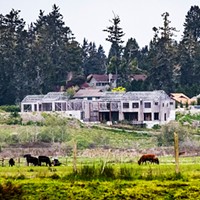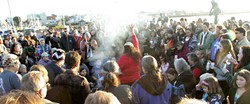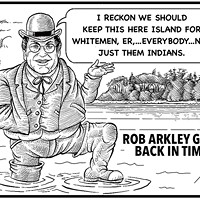[
{
"name": "Top Stories Video Pair",
"insertPoint": "7",
"component": "17087298",
"parentWrapperClass": "fdn-ads-inline-content-block",
"requiredCountToDisplay": "1"
}
]
Last week on Facebook I came across a post from the Wiyot Tribe in which it tagged my friend Rachel Sundberg. The tribe was thanking her for helping members learn about cultural protocols, dance regalia and continuing ceremonial practices. The Wiyot children in the photos were happy and in one photo a young girl was wearing a dress that I recognized, a dress that was worn by Wiyot tribal member Michelle Hernandez in 2014 when the Wiyot did their first women's coming-of-age ceremony in more than 100 years.
I must start here. Because most people would start on Feb. 26, 1860, when Humboldt County citizens massacred more than 150 Wiyot people who had just finished their World Renewal Ceremony. Humboldt County citizens came with hatchets and knives. They murdered mostly Indian women and children. That was the last time the Wiyot performed a World Renewal Ceremony on Tuluwat (what became known as "Indian Island").
I don't want to start there. Because the Wiyot are so much more than the massacring of their people. They have not only survived, they have thrived and they continue to restore and revitalize. In 2014 they brought back their women's coming-of-age ceremony and then they revitalized their World Renewal Ceremony on Tuluwat.
The city of Eureka has been working with the Wiyot for the return of Indian Island for a few years. The Wiyot Tribe purchased some of the island in 2000, which included an ancestral village. In 2006, the Eureka City Council voted to return another large part of the island to the Wiyot people. Then last week, Rob Arkley went on the KINS's Radio TalkShop and aired his opinions on the return of Tuluwat, stating, "Well, I use Indian Island. I like it. My kids do. I see people there all the time when I'm over there. I don't get how they can take one of our assets and give it. So I'm going to be offering over the appraised value for the property and if I get it, giving it away as surplus property ..."
A day later he (and his wife) issued a follow-up statement, including things like: "Now we have offered to purchase Indian Island, but we do not want to own it. We would rather preserve it for the entire community." And, "It is not our wish to deny the Wiyot Tribe access to sacred ceremonial grounds, or to their heritage, but to preserve the rights to the island for all citizens. It is a property with great historical significance and it belongs to all of us."
Look, we can go over the history of genocide in Humboldt County, the "deranged frontier" (as Jack Norton called it), the indiscriminate murder of Native people that founded this place, details like "Indian hunting days" and killing babies by stomping on their heads or cutting out their hearts. We can talk about how Native peoples were called "savage," while murderers were called "settlers." We can go over the statistics like the $1 million paid for the hunting and killing of Indians in the state of California and how everyday people traded in the scalps and heads of Indian people for money.
We can talk about the day that I was in the archive and came across a picture of Humboldt County "legend" Seth Kinman, who is described as a "hunter and early settler of the Humboldt County region," when, in fact, he was murdering psychopath who liked to pose for photos with Indian scalps. We could look at the Indian slave records in Humboldt County and talk about Native people who were sold into slavery in Old Town Eureka and how records show most of them were children.
We can call into question why the names of roads in our towns are the names of men who "settled" this place when settlement was not benign — it was depraved. We can reiterate that there are some families who benefited and continue to benefit from this violent history more than others; that Humboldt County's wealthy landowners did not get their land legally — they stole it, taking over large areas where Native peoples were forced out, often through massacres or enslavement.
We have no public memorials to the Native people who fought, bled, died and survived. In school, while children learn about a benign mission system, a prosperous gold rush and a "fair" rancho system, Native children grow up hearing about what their ancestors did to survive, because we want them to know: You are from a strong, enduring people. This water runs through you, this land has built you, and you will heal the community to heal the land, heal the land to heal the community.
That's right, I said "community." When Native people are talking about healing and preservation, they aren't just talking about building a better future for Indians, they are talking about building a better future for the earth. You live here, right? Earth? We need to find tangible ways to address the issues that we all still carry with us from this depraved history. How do we do that in a way that matters? How do we benefit for generations?
It's pretty simple: Return the land. Let the Wiyot decide how to move forward. You know why. Because it's not "giving Indian Island away," it's returning it to the rightful owners.
Let's say that you have this beautiful house that your family has been in for generations. And one day your dad sits you down and says, "You are about to inherit our family house. FYI, for us to gain ownership of the house, we came in the middle of the night and murdered everyone who lived here. And then it was ours. Also the extended family and descendants live just down the way. They sometimes come and hold vigils outside the house."
What do you do? Live in the murder house? It's not yours. At some point, a really wealthy dude turns up (maybe his name rhymes with Cob Carkley) and he says, "I understand that you are thinking about giving your house back to the family of the people your ancestors murdered. How about I offer you double the price and you don't give it back because I also want to use your house and my kids like it." Seems legit.
When I've offered versions of this example in class students have very clear reactions. (1) Don't steal other people's stuff. It's wrong; (2) if you inherit or benefit from someone who stole other people's stuff, you should do what you can to rectify that situation; (3) the easiest way to rectify that situation is to give the darn things back. It's that simple.
I'm trying to break it down into the simplest form but the truth is Tuluwat is much more than "stolen stuff." Tuluwat is not being returned because the Wiyot "want" it, it is being returned because that is the right thing to do. For everyone. For the entire community.
We are a part of the community, too, us Natives. Have been since the beginning of time. Will be. Always. The water runs through our veins. The land builds us. We pray for the health and well-being of all things, we sing, we dance, we heal the community to heal the land, we heal the land to heal the community. All of the community. Everything. Together.
Editor's note: This guest views piece was updated from a previous version to correct an error in the date of the Wiyot massacre. The Journal regrets the error.
Cutcha Risling Baldy is an assistant professor in Humboldt State University's Native American Studies Department. A version of this piece appears on her blog at www.cutcharislingbaldy.com.
Speaking of...
-

'Our Food is Our Medicine'
Mar 28, 2024 -

Despite Coastal Commission Appeal, Schneider Mansion Demolition, Restoration Could be Complete by July
Jan 9, 2024 -

Humboldt Bay Timeline
Oct 12, 2023 - More »
Comments (5)
Showing 1-5 of 5
more from the author
-
My Cousin Emmi
MMIW isn't statistics. It's my family.
- May 5, 2022
-
Every Number is a Person
Humboldt's missing and murdered Indigenous women, girls and Two Spirit people
- Aug 13, 2020
-
Representation Matters
Native people are doing awesome things but, please, let's talk about Johnny Depp
- Oct 3, 2019
- More »
Latest in Views
Readers also liked…
-
Hope
- Sep 7, 2023
-
California Says No to Privatizing Medicare
- Sep 21, 2023




































